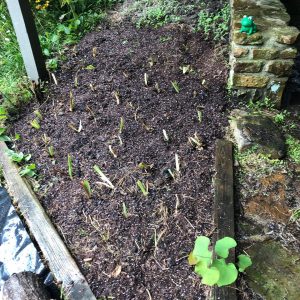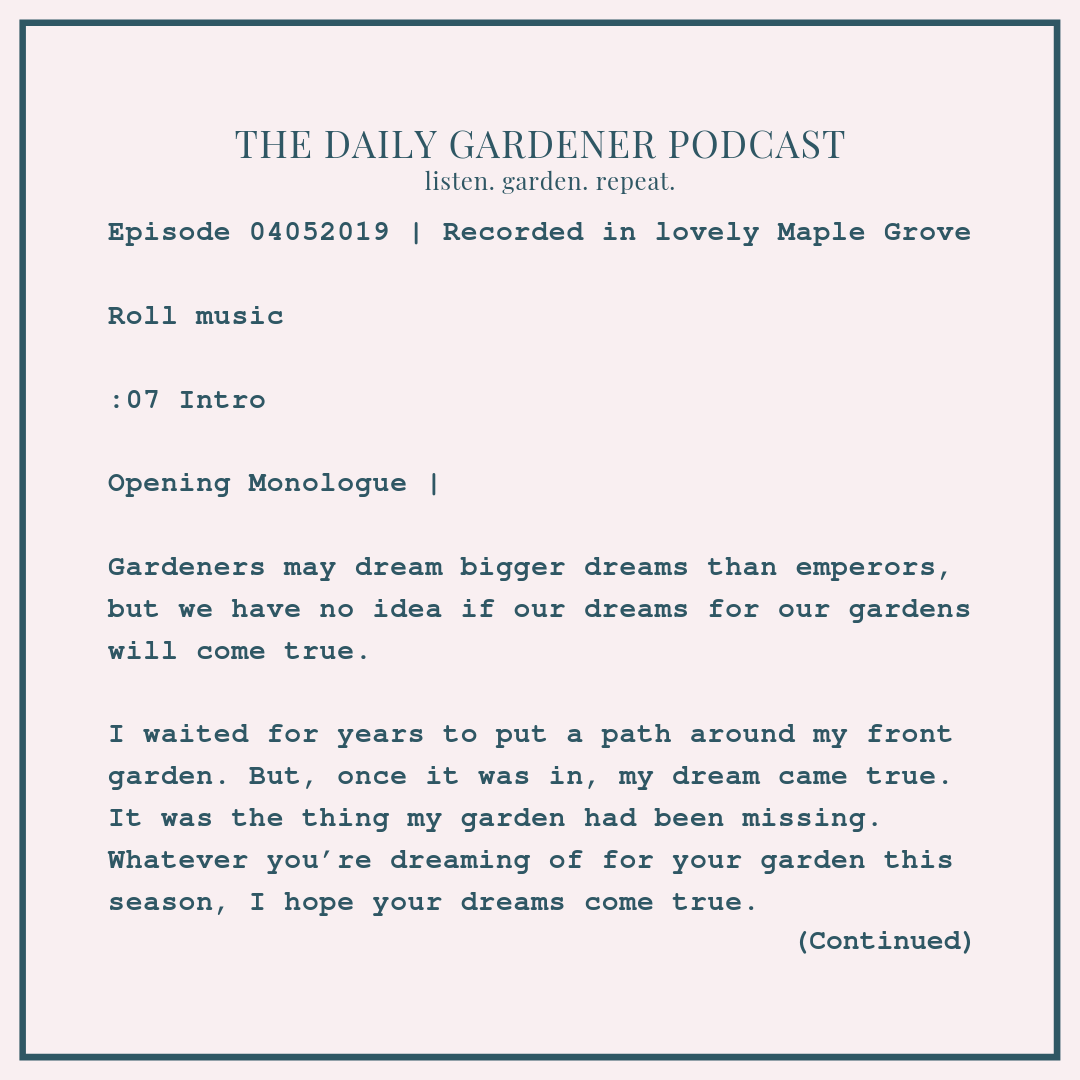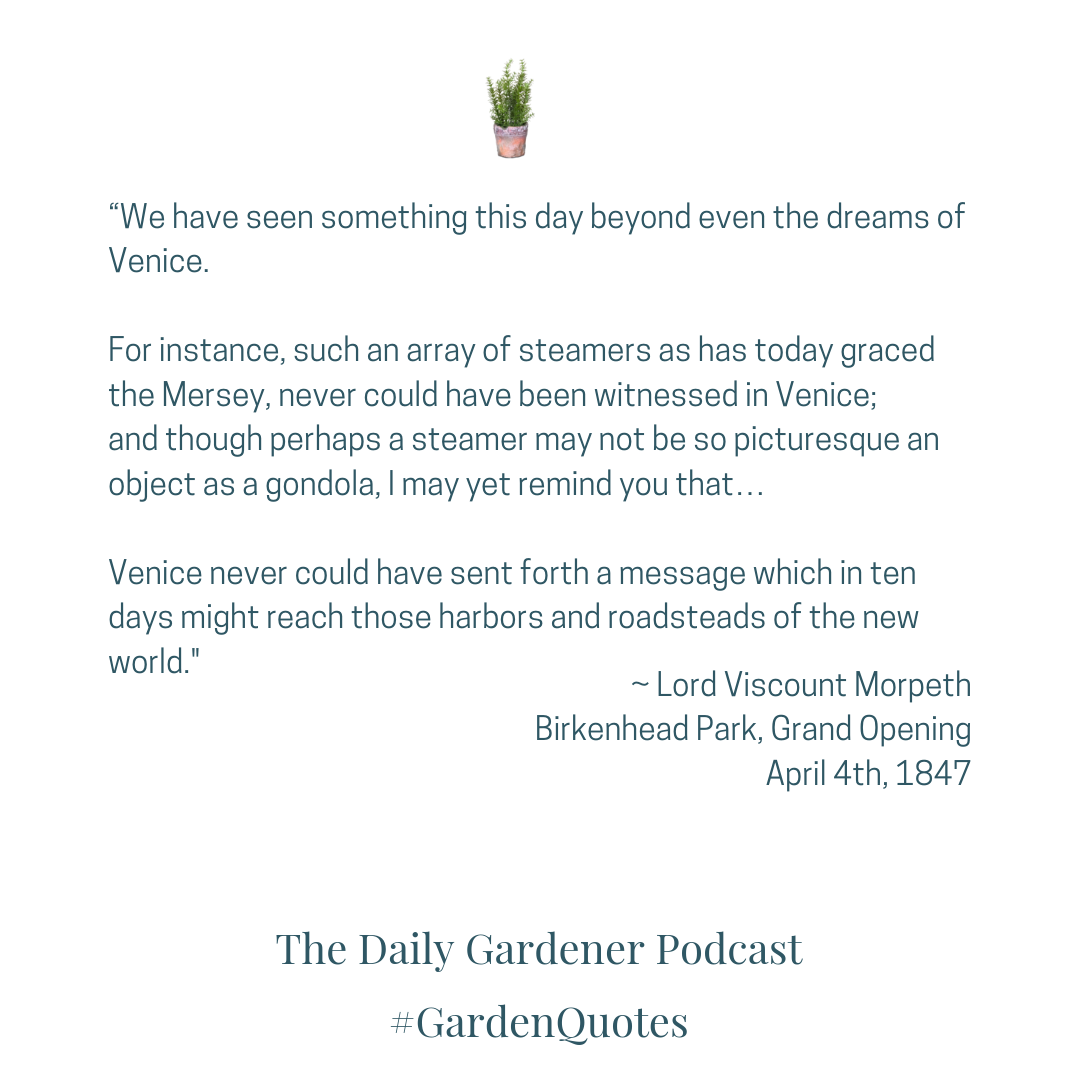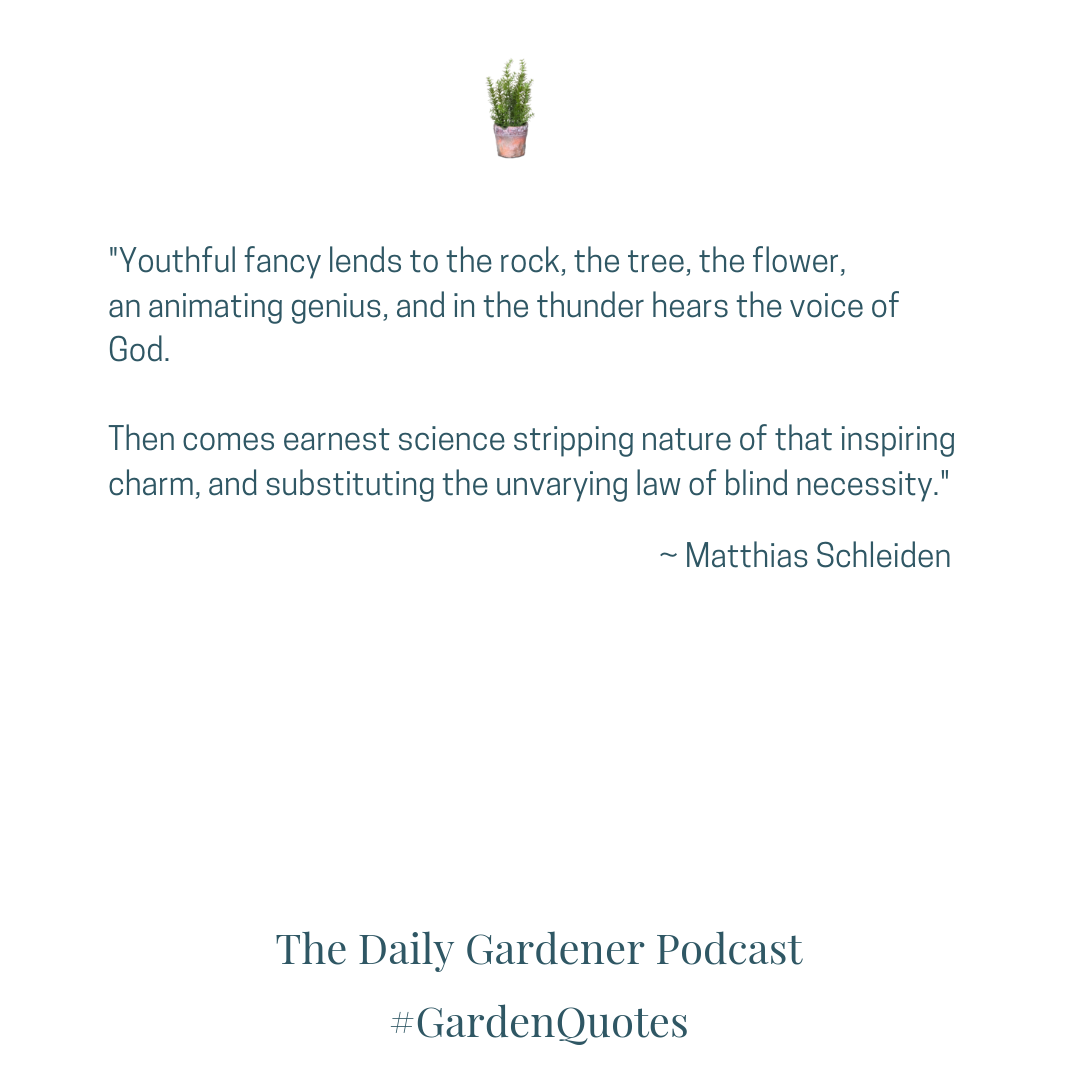September 17, 2019 Planting Iris like Mom with Rebecca Stoner Kirts, Olaus Rudbeck, Antoine Laurent de Jussieu, Peter Barr, The Milkweed Poem, Hot Color Dry Garden by Nan Sterman, Pumpkin Care, and the Story of a Grass Reader
Listener Rebecca Stoner Kirts recently shared a photo in the Facebook Group of her transplanted iris along with an enchanting caption.
She wrote:
Mom's 50 year iris rescued and replanted. Mom always told me, “they like their own space and plant them like ducks floating on a pond."
There you go mom.
Rebecca's mom's analogy of planting iris-like ducks floating on the pond is a good one to remember.
As I mentioned on a show a while back, they don't like to be buried. They don't want to be planted deep. So, yes, to dividing them and yes to replanting, but when you do replant them, let them skim the surface of your garden. I like to nestle mine in just a bit, and then I stake them in, so they don't fall over and can stand up and get used to their new place in the garden.
Brevities
#OTD Today is the anniversary of the death of Olaus Rudbeck, who died on this day in 1702.
Olaus Rudbeck was born in Sweden. He was a "Renaissance man." He contributed to medicine, especially anatomy. Rudbeck was a professor at the University of Uppsala, where he taught medicine, botany, mathematics, astronomy, and architecture. One of his most important discoveries came when he was just 22 years old; Rudbeck discovered the lymphatic vessels and the lymphatic system in 1650.
1702 will forever be remembered in Swedish history as the year Upsala burned. The fire swept through the town, and it made its way to the University. Rudbeck was 72 years old, and he ran to the top of the theater, where he taught anatomy to direct the firemen and people trying to save the campus. He reportedly could be heard even over the din of the chaos. While he was leading activities at the University, he was informed that his own home and his private personal collections and writings were on fire. Rudbeck did not leave his post. Thanks to Rudbeck, the University Library, and valuable collections were saved. Walking through the town of Upsala, which lay in ruin, Rudbeck immediately began to draw up plans for the city. His vision was carried out without him, though. Rudbeck died four months later on this day in 1702.
Twenty-nine years later, Carl Linnaeus, the ‘Father of Plant Taxonomy,' named the Rudbeckia, or Black-Eyed Susan, after his patron Olaus Rudbeck. On July 29, 1731, Linnaeus wrote with admiration about his old professor, Rudbeck, saying:
"So long as the earth shall survive and as each spring shall see it covered with flowers, the Rudbeckia will preserve your glorious name."
Black-Eyed Susans are a favorite of gardeners. They bloom continuously from about mid-July until the first frost. The black-eyed Susan is a great pollinator plant. As a member of the daisy family, they offer that daisy shape and give the garden a warm yellow color. All that Black-Eyed Susans require is the sun. All gardeners need to do is enjoy them and remember to cut a few to bring indoors; they are a fantastic cut flower. They play nice in bouquets, and they look great as a solo flower in a vase.
There have been new varieties of Black-Eyed Susans introduced over the past couple of decades. In honor of the 150th anniversary of the city of Denver, the Denver Daisy was introduced in 2008. It is a cross between the Rudbeckia hirta species and the Rudbeckia prairie sun.
One of my personal favorites is the Rudbeckia hirta 'Cherry brandy.' Imagine a red Black-Eyed Susan, and that's basically Cherry brandy. Simply gorgeous.
When I was researching Olaus Rudbeck, I ran across two fascinating stories about him from a biographical piece by a woman named Frederica Rowan. I share the first one now, and I'll tell you the other at the end of the show.
Here we go.
Olaus Rudbeck, the man honored with the Black-Eyed Susan, apparently had the voice of an angel. He also had great taste, and he knew how to through a party. So, in 1660, he was put in charge of pulling together the coronation of Charles XI of Sweden where it was reported,
"That at a concert given in honor of the coronation of Charles XI (of Sweden), his voice was distinctly heard in a solo air "above the accompaniment of twelve trumpeters, all blowing with their whole might ;" and that on another occasion, when already advanced in life, he imitated the sound of cannon with his mouth, to the great delight of the future hero, Charles XII, then a boy of seven years, who clapped his hands with joy."
#OTD Today is the anniversary of the death of Antoine Laurent de Jussieu, who died on this day in 1836.
was a French botanist who developed the first natural classification of flowering plants.
Today, there's a metro station near the botanical garden in Paris that is named in honor of the Jussieu family - which boasted five members over several generations as notable botanists. The two oldest Jussieu brothers, Antoine and Bernard, were both botany professors in Paris. Bernard was the stronger botanist of the two brothers. Once, after botanizing in Lebanon, Bernard shared his water with the little Lebanon Cedar seedling he was bringing back to Paris. The seedling lived to be over 200 years old and eighty feet high.
As for Bernard Jussieu, he began organizing the garden at Versailles in more natural order, but he wouldn't tell others his method for organizing plants. Antoine-Laurent de Jussieu was Antoine's son and Bernard's nephew. When he came of age, he trained under his uncle for four years, and Bernard recognized in Antoine-Laurent the person with whom he could trust his work. As a result, Antoine-Laurent began his work as an extension of his Uncle Bernard's ideas around grouping plants.
It took Jussieu almost 20 years of refinement and perfecting, but he finally published his work on natural classification as the Bastille was falling in 1789. In Genera Plantarum, Antoine-LaurentJussieu kept Linnaeus' binomial nomenclature, but he grouped plants by genera and then into families. He called his system natural and strived to let nature be his guide. Today, many plant families can be attributed to Jussieu.
#OTD Today is the anniversary of the death of the Scottish horticulturist known as "The Daffodil King, Peter Barr, who died on this day at the age of 84 years old in 1909.
Since Queen Victoria was not a fan of daffodils, Barr had much to overcome. At his home in Surrey, he bred over 2 million daffodils. Not surprisingly, people would travel from all around to see the spring profusion of 120 separate daffodil varieties at Barr's nursery. Over time, Barr earned the moniker "The Daffodil King," and he is credited as the man who popularized the daffodil. At one point, the Peter Barr daffodil - a white trumpet variety - commanded $250 a bulb.
When Barr retired, he went to Scotland and grew primroses.
Two years before his death, Barr mused,
"I wonder who will plant my grave with primroses?"
When Barr died, his obituary stated he was known from "one end of Great Britain to the other."
After Barr's death, the Royal Horticultural Society has awarded the Peter Barr Memorial Cup for excellence in daffodils.
Today, In about five days, there will be a Grand Plaque Unveiling at Barr's English home celebrating The Daffodil King, Peter Barr.
Unearthed Words
"The milkweed pods are breaking,
And the bits of silken down
Float off upon the autumn breeze
Across the meadows brown."
- Cecil Cavendish, The Milkweed
"September: it was the most beautiful of words, he’d always felt, evoking orange-flowers, swallows, and regret."
- Alexander Theroux, 1981
Today's book recommendation: Hot Color Dry Garden by Nan Sterman
This is a fantastic book for gardeners looking to have a colorful garden that's also drought-tolerant. Nan, who also writes a gardening column for the San Diego Union-Tribune, offers incredible sustainable designs and more than 150 fantastic plant selections for the water-wise gardener. If you think a dry garden can't be colorful, think again. Nan shows you the plants that pack the most punch color-wise, and she challenges all of us to stop thinking dry means drab.
Today's Garden Chore
Nudge your pumpkins along in time for Halloween.
You can do this in several ways. One of the simplest things you can do is remove any leaves that are shadowing the fruit. You can also elevate your pumpkins by putting them on a piece of wood to prevent rot.
Something Sweet
Reviving the little botanic spark in your heart
Alright, as promised, here's the second remarkable story about Olaus Rudbeck. One I hope you'll carry with you and share with others, primarily if you teach horticulture in some fashion or work with kids in horticulture.
When Rudbeck was first appointed assistant professor of medicine at the University of Upsala, Rudbeck was quite intent on sharing everything he had learned about botany. He prepared a public display of his collection, and he had put together a lecture about the collection of new seeds and roots he had brought with from his travels abroad.
But the students at the time thought botany was a topic for old ladies or apothecaries or pharmacists, and they derided anyone with interest in the subject by calling them " a grass reader." Rudbeck, who was clearly out of touch with the perception of botany, expected to find his lecture room filled. It says he waited "hour after hour," but not one person showed up.
Then Rowan wrote this about Rudbeck, and it is just so incredibly moving to me:
"His disappointment was great; for once, the brave spirit gave way, and he burst into tears. But, recovering from his momentary weakness, he determined, in spite of the existing indifference, to do for botany what he had done for anatomy.
He instantly set about converting a piece of ground which he possessed in Upsala into a botanical garden, with hot-houses, and bowers, and shady walks, and parterres resplendent with the variegated hues of the newly imported plants, to attract by beauty those whom science lacked charms to lure. And when his task was completed, and knots of admiring visitors gathered round him in his garden, he would assume the character of a peripatetic lecturer, and instill knowledge into them, even against their will: thus breaking the ground for Linnaeus, whose fame was to outshine his own in the annals of botany, and laying the foundations of the very garden, the renown of which was to become world-wide under his great successor."
Thanks for listening to the daily gardener,
and remember:
"For a happy, healthy life, garden every day."
What Listeners Say
KIND WORDS FROM LOVELY LISTENERS
"I just discovered you!
I googled garden podcasts and
I'm so glad I found the show.
I start every day with The Daily Gardener!"
"I love gardening.
I been gardening for over 40 years.
A friend got me started on listening to gardening podcasts and yours just popped up.
I am all the richer for it!"
"I've been a Still Growing podcast listener for years.
You are so welcoming and your voice is so soothing!
I love The Daily Gardener because it's different. I can't imagine how much work it is to make a show like this but I thank you for it."
SI HORTUM IN HORTORIA PODCASTA IN BIBLIOTEHCA HABES, NIHIL DEERIT.














